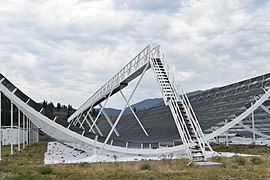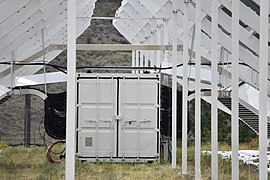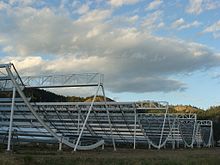
Dark matter is a hypothetical form of matter thought to account for approximately 85% of the matter in the universe. Dark matter is called "dark" because it does not appear to interact with the electromagnetic field, which means it does not absorb, reflect, or emit electromagnetic radiation and is, therefore, difficult to detect. Various astrophysical observations – including gravitational effects which cannot be explained by currently accepted theories of gravity unless more matter is present than can be seen – imply dark matter's presence. For this reason, most experts think that dark matter is abundant in the universe and has had a strong influence on its structure and evolution.

In gamma-ray astronomy, gamma-ray bursts (GRBs) are immensely energetic explosions that have been observed in distant galaxies. They are the most energetic and luminous electromagnetic events since the Big Bang. Bursts can last from ten milliseconds to several hours. After an initial flash of gamma rays, a longer-lived "afterglow" is usually emitted at longer wavelengths.
In physical cosmology, a protogalaxy, which could also be called a "primeval galaxy", is a cloud of gas which is forming into a galaxy. It is believed that the rate of star formation during this period of galactic evolution will determine whether a galaxy is a spiral or elliptical galaxy; a slower star formation tends to produce a spiral galaxy. The smaller clumps of gas in a protogalaxy form into stars.
In the fields of Big Bang theory and cosmology, reionization is the process that caused matter in the universe to reionize after the lapse of the "dark ages".

MAGIC is a system of two Imaging Atmospheric Cherenkov telescopes situated at the Roque de los Muchachos Observatory on La Palma, one of the Canary Islands, at about 2200 m above sea level. MAGIC detects particle showers released by gamma rays, using the Cherenkov radiation, i.e., faint light radiated by the charged particles in the showers. With a diameter of 17 meters for the reflecting surface, it was the largest in the world before the construction of H.E.S.S. II.

The Square Kilometre Array (SKA) is an intergovernmental radio telescope project being planned to be built in Australia (low-frequency) and South Africa (mid-frequency). The combining infrastructure, the Square Kilometre Array Observatory (SKAO) is located in the United Kingdom. Conceived in the 1990s, and further developed and designed by the late-2010s, when completed sometime in the 2020s it will have a total collecting area of approximately one square kilometre. It will operate over a wide range of frequencies and its size will make it 50 times more sensitive than any other radio instrument. It will require very high performance central computing engines and long-haul links with a capacity greater than the global Internet traffic as of 2013. If built as planned, it should be able to survey the sky more than ten thousand times faster than before.

The Low-Frequency Array, or LOFAR, is a large radio telescope, with an antenna network located mainly in the Netherlands, and spreading across 7 other European countries as of 2019. Originally designed and built by ASTRON, the Netherlands Institute for Radio Astronomy, it was first opened by queen Beatrix of The Netherlands in 2010, and has since been operated on behalf of the International LOFAR Telescope (ILT) partnership by ASTRON.

The Allen Telescope Array (ATA), formerly known as the One Hectare Telescope (1hT), is a radio telescope array dedicated to astronomical observations and a simultaneous search for extraterrestrial intelligence (SETI). The array is situated at the Hat Creek Radio Observatory in Shasta County, 290 miles (470 km) northeast of San Francisco, California.
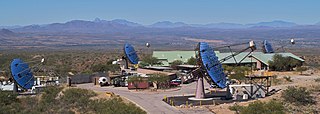
VERITAS is a major ground-based gamma-ray observatory with an array of four 12 meter optical reflectors for gamma-ray astronomy in the GeV – TeV photon energy range. VERITAS uses the Imaging Atmospheric Cherenkov Telescope technique to observe gamma rays that cause particle showers in Earth's atmosphere that are known as extensive air showers. The VERITAS array is located at the Fred Lawrence Whipple Observatory, in southern Arizona, United States. The VERITAS reflector design is similar to the earlier Whipple 10-meter gamma-ray telescope, located at the same site, but is larger in size and has a longer focal length for better control of optical aberrations. VERITAS consists of an array of imaging telescopes deployed to view atmospheric Cherenkov showers from multiple locations to give the highest sensitivity in the 100 GeV – 10 TeV band. This very high energy observatory, completed in 2007, effectively complements the Large Area Telescope (LAT) of the Fermi Gamma-ray Space Telescope due to its larger collection area as well as coverage in a higher energy band.

The Dominion Radio Astrophysical Observatory is a research facility founded in 1960 and located at Kaleden, British Columbia, Canada. The site houses four radio telescopes: an interferometric radio telescope, a 26-m single-dish antenna, a solar flux monitor, and the Canadian Hydrogen Intensity Mapping Experiment (CHIME) — as well as support engineering laboratories. The DRAO is operated by the Herzberg Institute of Astrophysics of the National Research Council of the Government of Canada. The observatory was named an IEEE Milestone for first radio astronomical observations using VLBI.
The National Astronomical Observatories, Chinese Academy of Sciences(NAOC, Chinese: 中国科学院国家天文台; pinyin: Zhōngguó Kēxuéyuàn Guójiā Tiānwéntái) is an astronomical research institute operated by Chinese Academy of Sciences, along with Shanghai Astronomical Observatory, Purple Mountain Observatory and National Time Service Center.
In cosmology, baryon acoustic oscillations (BAO) are fluctuations in the density of the visible baryonic matter of the universe, caused by acoustic density waves in the primordial plasma of the early universe. In the same way that supernovae provide a "standard candle" for astronomical observations, BAO matter clustering provides a "standard ruler" for length scale in cosmology. The length of this standard ruler is given by the maximum distance the acoustic waves could travel in the primordial plasma before the plasma cooled to the point where it became neutral atoms, which stopped the expansion of the plasma density waves, "freezing" them into place. The length of this standard ruler can be measured by looking at the large scale structure of matter using astronomical surveys. BAO measurements help cosmologists understand more about the nature of dark energy by constraining cosmological parameters.

The Australian Square Kilometre Array Pathfinder (ASKAP) is a radio telescope array located at Murchison Radio-astronomy Observatory (MRO) in the Mid West region of Western Australia. It is operated by the Commonwealth Scientific and Industrial Research Organisation (CSIRO) and forms part of the Australia Telescope National Facility. Construction commenced in late 2009 and first light was in October 2012.

In radio astronomy, a fast radio burst (FRB) is a transient radio pulse of length ranging from a fraction of a millisecond to 3 seconds, caused by some high-energy astrophysical process not yet understood. Astronomers estimate the average FRB releases as much energy in a millisecond as the Sun puts out in 3 days. While extremely energetic at their source, the strength of the signal reaching Earth has been described as 1,000 times less than from a mobile phone on the Moon. The first FRB was discovered by Duncan Lorimer and his student David Narkevic in 2007 when they were looking through archival pulsar survey data, and it is therefore commonly referred to as the Lorimer Burst. Many FRBs have since been recorded, including several that have been detected to repeat in seemingly irregular ways. Only one FRB has been detected to repeat in a regular way: FRB 180916 seems to pulse every 16.35 days.
In cosmology, intensity mapping is an observational technique for surveying the large-scale structure of the universe by using the integrated radio emission from unresolved gas clouds.
The Hydrogen Intensity and Real-time Analysis eXperiment (HIRAX) is an interferometric array of 1024 6-meter (20ft) diameter radio telescopes, operating at 400-800MHz, that will be deployed at the Square Kilometer Array site in the Karoo region of South Africa. The array is designed to measure red-shifted 21-cm hydrogen line emission on large angular scales, in order to map out the baryon acoustic oscillations, and constrain models of dark energy and dark matter.

Ingrid Stairs is a Canadian astronomer currently based at the University of British Columbia. She studies pulsars and their companions as a way to study binary pulsar evolution, pulsar instrumentation and polarimetry, and Fast Radio Bursts (FRBs). She was awarded the 2017 Rutherford Memorial Medal for physics of the Royal Society of Canada, and was elected as a Fellow of the American Physical Society in 2018.
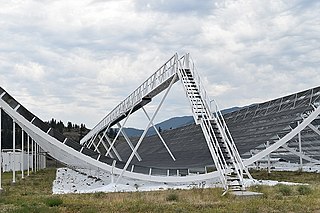
FRB 20180916B, is a repeating Fast radio burst (FRB) discovered in 2018 by astronomers at the Canadian Hydrogen Intensity Mapping Experiment (CHIME) Telescope. According to a study published in the 9 January 2020 issue of the journal Nature, CHIME astronomers, in cooperation with the radio telescopes at European VLBI Network (VLBI) and the optical telescope Gemini North on Mauna Kea, Hawaii, were able to pinpoint the source of FRB 180916 to a location within a Milky Way-like galaxy named SDSS J015800.28+654253.0. This places the source at redshift 0.0337, approximately 457 million light-years from the Solar System.

SGR 1935+2154 is a soft gamma repeater (SGR) that is an ancient stellar remnant, in the constellation Vulpecula, originally discovered in 2014 by the Neil Gehrels Swift Observatory. Currently, the SGR-phenomena and the related anomalous X-ray pulsars (AXP) are explained as arising from magnetars. On 28 April 2020, this remnant about 30,000 light-years away in our Milky Way galaxy was observed to be associated with a very powerful radio pulse known as a fast radio burst or FRB, and a related x-ray flare. The detection is notable as the first FRB detected inside the Milky Way, and the first to be linked to a known source. Later in 2020, SGR 1935+2154 was found to be associated with repeating fast radio bursts.


